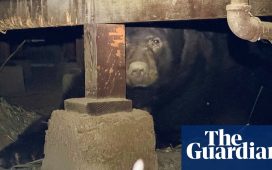A beetle that has previously devastated Norway spruce populations across continental Europe has been found to be equally attracted to the Sitka spruce, a finding experts say could have significant implications for commercial forestry.
The eight-toothed European spruce bark beetle has now been found in the UK, raising fears for the Sitka, which accounts for a quarter of Britain’s forest cover and half its commercial forestry plantations.
Researchers said they did not know initially whether the insect would be as attracted to the Sitka spruce.
They assessed how the beetles chose their hosts using freshly cut spruce logs, and then verified the findings in the field in an area with an endemic population of the beetle.
The findings revealed colonisation and breeding success were similar in cut Sitka and Norway spruce material. The team found the odours of aged wood from the two species of evergreen coniferous trees were equally attractive to the beetles, but that fresh Sitka spruce was more so than fresh Norway spruce.
“Our research shows the beetle may successfully find and colonise felled or wind-snapped Sitka spruce as readily as cut Norway spruce, which may increase its establishment risk in Sitka-growing regions,” said the study lead, Dr Jozsef Vuts, a chemical ecologist at Rothamsted, one of the oldest agricultural research institutions in the world.
“Pheromone traps are currently used to monitor where the beetles are in the UK and how the outbreaks are developing. In terms of management, quick removal of felled timber or wind-damaged trees from the forest could be needed,” he added.
Since 2013, more than 100m cubic metres of Norway spruce have been killed by the pest across Europe.
Eight-toothed European spruce bark beetles are usually associated with windblown, damaged and recently felled spruce trees, where the insects build up numbers before moving on to attack adjacent live trees.
The beetles attack the trees, overcoming the plant’s usual defences with large numbers. The insect can spread pathogenic fungi and is closely associated with blue-stain fungus, which can weaken the spruces. The combination can lead to extensive tree deaths, researchers have warned.
after newsletter promotion
Dr Daegan Inward, of Forest Research and one of the authors of the study, said further investigation may need to be done to gain a clearer picture on the threat of the beetle. “The populations in continental Europe have erupted over the last 10-15 years to a really unprecedented level,” he said.
“It is a native beetle to Europe but not present in the UK until very recently. Every so often you get these outbreaks of very large populations [of the beetle] that essentially shift the beetle from being a minor pest of felled material or storm damage material to the point where they can actually start attacking live healthy trees, and this is what we are seeing on the continent.
“We’re developing experiments where we are going to precipitate attacks of beetles on to these trees for direct comparison to see how the two spruce species defend themselves against the beetle.”












